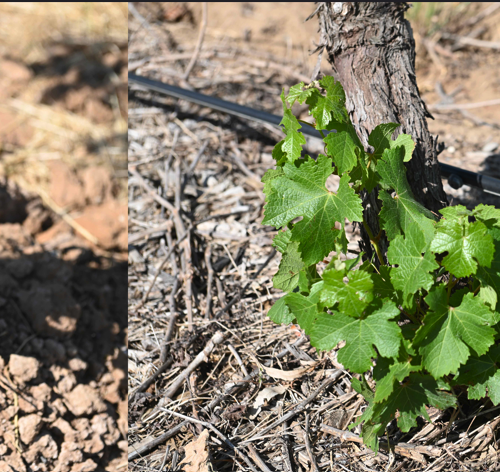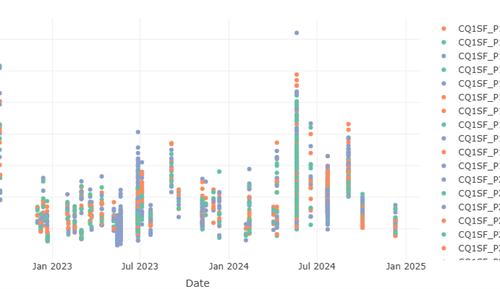Vinod Phogat, Tim Pitt, Paul Petrie, Kavitha Shanmugam, Mark Skewes and Dane Thomas.*
The Australian almond industry has expanded from 7038 ha to 60,463 ha since 2006, with most plantings being irrigated with efficient drip systems.
Many new orchards are exploring higher density plantings as a mechanism to boost orchard production potential. High density plantings promote rapid canopy fill and higher light interception targeting increased and early productivity gains.
However, modifications to planting density also require optimisation of water and nutrient delivery systems that promote sustainable irrigation and fertigation scheduling aligned to the crop demand.
There are numerous challenges in the estimation of water and fertiliser requirement of a crop, such as timing, amount, and mode of application.
Nitrogen is a key fertiliser in almond production, which can be applied in excess of orchard needs with the intention to avoid limiting nut production. Excess application not only increases the cost of production (through high fertiliser costs) but can reduce nut quality (increased susceptibility to hull rot and Carpophilus beetle).
Excess nitrogen leaching into the groundwater can also pose a risk to the environment. Therefore, assessment of alternate production systems including soil, water, crop and climate is important for developing sustainable irrigation and fertiliser guidelines.
Estimating crop water and nutrient use through numerical models is one of the key objectives in the almond planting density trials being conducted at the Almond Centre of Excellence (ACE) at Loxton. Here we report some results on seasonal water and nitrogen balance and efficiency of use by three-year-old Nonpareil almond plantings under three densities (308, 440 and 615 trees/ha) during the 2020-21 season.
Methods
This study is the part of SARDI’s almond density optimisation trial established at the Almond Centre of Excellence (ACE) at Loxton. Four varieties of almonds (Nonpareil, Carina, Vela, and Shasta) were planted in 2018, in plots comprised of four rows bordered by two buffer rows, replicated six times in a Latin square design.
Row spacing was fixed (6.5m) and the planting distance between trees along the rows decreased from 5 to 2.5m at 0.5m increments to produce six density treatments ranging from 308 to 615 trees/ha. A modelling study estimated the water and nitrogen balance and usage efficiency for three of the planting densities (615, 440 and 308 trees/ha).
The model (HYDRUS-2D) was calibrated and validated for water and nitrogen movement in the experimental field incorporating measured data on soil, canopy, climate, irrigation and fertigation schedules.
The modelling domain with imposed system boundaries, irrigation system design, soil moisture probe and soil solution extractors is shown in Figure 1a. Some preliminary results observed for Nonpareil genotype during 2020–21 (3rd leaf) are reported here.

Figure 1. Schematic diagram showing sensor locations, modelling domain, boundary conditions and
(b) predicted nitrate movement in the soil during flowering, kernel filling and post-harvest period of 2019–20 and 2020–21 seasons.
Results
The model’s predicted seasonal water balance components for two seasons at different densities (308, 440, and 615 trees/ha) are shown in Figure 2. Low density (308 trees/ha) plantings not only had reduced water uptake, but seasonal drainage was double, compared to high density (615 trees/ha).
Root water uptake for the high density (615 trees/ha) Nonpareil trees was increased by 10% as compared to low density (308 trees/ha). This suggests that 615 tree/ha density can enhance root water uptake, through increasing root biomass to extract water more efficiently from the rootzone.

Figure 2 Model predicted (a) seasonal water balance components (irrigation – I, Rainfall – R, root water uptake – RWU, drainage– Dr, evaporation – Es, soil depletion– ∆S) and (b) nitrogen balance (ammonium nitrogen added – NH4-N_add, nitrate nitrogen added – NO3-N_add, ammonium uptake – NH4-N_rwu, initial ammonium in the soil – NH4-N_ini, nitrification of added ammonium – NH4-N_Ni, nitrate nitrogen uptake – NO3-N_rwu, nitrate leaching – NO3-N_dr, nitrate remaining in the soil – NO3-N_end under Nonpareil almond planted at different densities (308, 440, and 615 trees/ha) during 2020–21.
However, long-term observations are required to understand the true competitive behaviour of high-density plantings for effective water use when the trees are grown to full maturity.
Nitrogen uptake by Nonpareil accounted for almost 70% of the total N applied as fertilisers, while 14 –20% leached deeper in the soil across all densities. N Leaching was higher under low density (308 trees/ha) as compared to high density planting (615 trees/ha).
High concentration of NO3-N (nitrates) near the soil surface was observed in the modelling simulation during late December-January which was associated with the upward movement of water due to increased surface evaporative flux, which removed water but left N behind (Figure 1b).
The high concentration of NO3-N in the soil coincided with the hull split stage of almond growth and may encourage pest and disease issues such as hull rot and Carpophilus beetle. High amounts of N remained in the soil when the trees entered dormancy, exposing it to potential leaching from the root zone with subsequent winter rainfall.
This indicates that the NO3-N application was higher than the demand, and the young trees (3-years old) were unable to take up all the N added through fertigation, causing NO3-N to build up in the soil.
Water productivity (WP) of almonds (kg of kernels/m3 of water) under different planting densities was estimated, for the first commercial crop in 2021, as the kernel yield divided by three measures of water use, i.e., amount of irrigation (WPI), seasonal evapotranspiration (WPET) and crop transpiration (WPT).

Figure 3 Water productivity (kg/m3) of Nonpareil almond in relation to (a) irrigation (WPI) applied, crop evapotranspiration (WPET)
and transpiration (WPT), and (b) Nitrogen use efficiency in terms of kernel yield (NUEy) and fertiliser applied (NUEf) under different planting densities.
Water productivity by all measures (WPI, WPET, WPT) increased with an increase in the planting density (Figure 3). High density (615 trees/ha) Nonpareil trees showed 42–62% higher WP than under low density planting (308 trees/ha).
Nitrogen use efficiency (NUE) in terms of kernel yield (NUEy), which means kg of kernel/kg of N applied, showed a positive response to increasing planting density (Figure 3).
The N uptake efficiency in term of N fertiliser added (NUEf), which means kg of N uptake/kg of N applied, showed very little response to increase in planting density.
These early results suggest an opportunity to develop more efficient almond growing systems compared to the tradition lower density orchards. However, modelling and field measurements need to be carried out over a much longer term to confirm this conclusion. A more intensive spatiotemporal sampling program would further strengthen the model calibration for N transport processes.
Next Steps:
Similar studies of water and nitrogen dynamics will be carried out for Nonpareil and other genotypes planted at different densities as canopies grow towards mature almond trees, as part of AL21001 Project on Optimising Almond Production System. This will help developing better understanding of water and nitrogen application for achieving efficient almond growing systems.
Acknowledgements
This work was funded by Hort Innovation using the Almond Research and Development Levy with co-investment from the South Australian Government and funds from the Australian Government. For more information on these funds and strategic levy investments visit horticulture.com.au. Thanks also to the Almond Board of Australia for managing field operations in the experimental trial.
*Vinod Phogat, Tim Pitt, Paul Petrie, Kavitha Shanmugam, Mark Skewes and Dane Thomas are researchers at the Department of Primary Industries and Regions research division, South Australian Research and Development Institute (SARDI). Contact: mailto:Vinod.Phogat@sa.gov.au




